The Kandy Esala Perahera festival is a traditional cultural celebration held yearly in Kandy. The Temple of the Tooth Relic and the Four Great Devala conduct this festival. The event, held in August, is the most popular element of the Esala festival, which begins on the day of the Esala half-moon.
This festival has become a cultural icon for Sri Lanka and is a Buddhist event that includes dances and elaborately decorated elephants. Fireballers’ dances, whippers’ dances, upland dances, and several other cultural dances are included. The traditional water-cutting event held on the Nikini fortnight Poya day marks the completion of this event.
The Kandy Esala Perahera
Historical Background
The Kandy Perahera festival holds a rich historical background that dates back centuries. Its origins can be traced to ancient Sri Lanka, particularly during the reign of King Kirthi Sri Meghavarna (301-328 CE). However, it is important to note that The festival has changed through time and now includes a variety of cultural themes.
The Esala Perahera is closely associated with the veneration of the sacred tooth relic of the Buddha, which is believed to have been brought to Sri Lanka in the 4th century CE. The tooth relic is considered the most sacred relic in Buddhism and holds significant religious and cultural importance for Sri Lankans.
According to historical details, during the reign of King Keerthi Sri Meghavarna, the sacred tooth relic was enshrined in the city of Anuradhapura. However, due to various invasions and political instability, the relic was transferred from Anuradhapura to various locations for safekeeping. Eventually, it found its permanent residence in the Kingdom of Kandy, where the present-day Temple of the Sacred Tooth Relic stands.
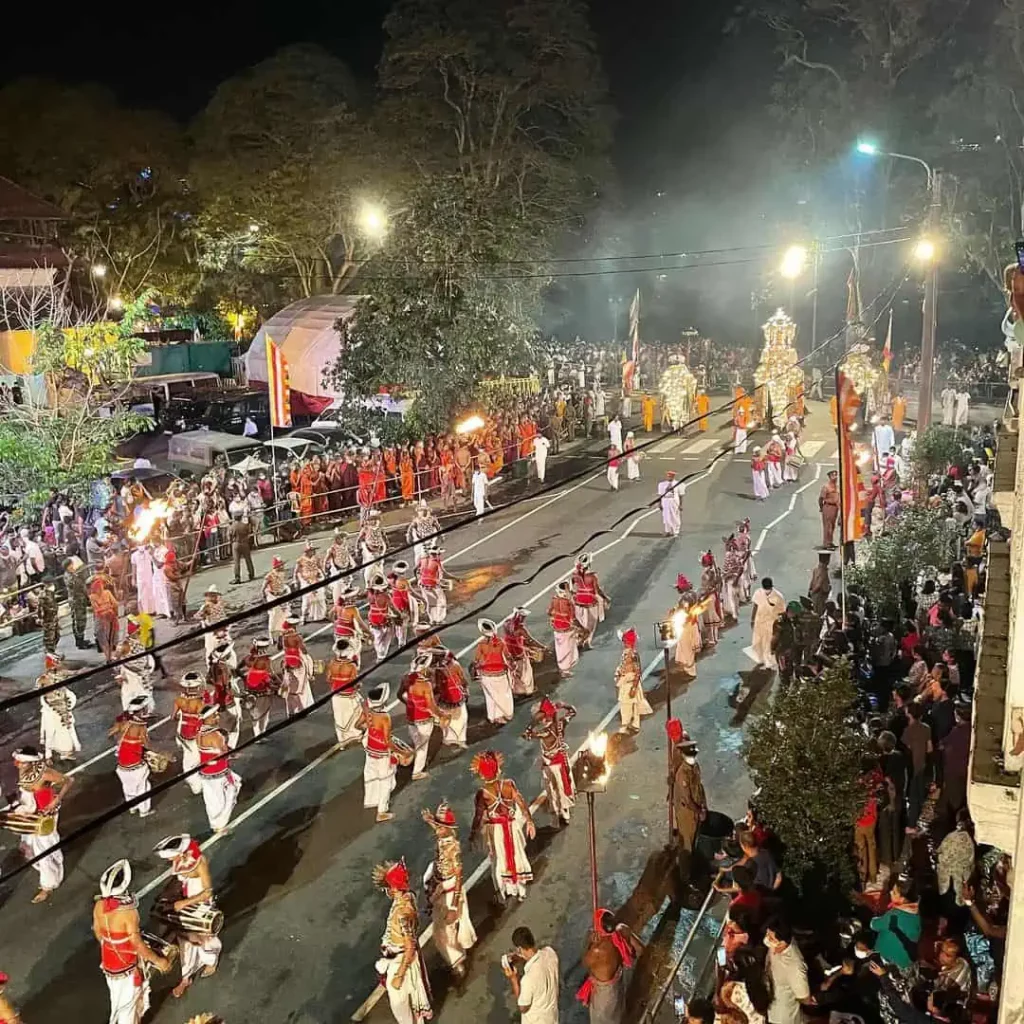
The Kandy Perahera festival is said to have originated in Kandy during the reign of King Rajasinghe II (1635-1687 CE). The king is believed to have inaugurated the Perahera as a means to seek blessings from the deities for rainfall and harvest, as well as to invoke divine protection for the kingdom.
Over the centuries, the Perahera has evolved into a grand procession, showcasing the sacred tooth relic and honoring the deities associated with Buddhism and indigenous Sri Lankan beliefs. The celebration includes components from Buddhism, Hinduism, and folk customs, reflecting the island’s multicultural nature. There are several nights of meticulously choreographed parades through the streets of Kandy, each night’s Perahera becoming progressively more vibrant and grand, culminating in the Randoli Perahera, the final and most spectacular night of the festival.
Today, the Kandy Perahera stands as one of the most significant cultural and religious events in Sri Lanka, attracting both local and international visitors. It continues to honor the ancient traditions, preserve the heritage, and exemplify the deep spiritual devotion of the Sri Lankan people.
The Legends and Myths
The Esala Perahera festival in Kandy, Sri Lanka, is intertwined with several legends and myths that add depth and charisma to its significance. Here are a few notable legends and myths associated with the festival:
The Tooth Relic and Princess Hemamala:
According to legend, during the reign of King Kirti Sri Meghavarna in Anuradhapura, a tooth relic of the Buddha was brought to Sri Lanka from India. It is believed that the relic was concealed within the hair of Princess Hemamala, who undertook a perilous journey from India to Sri Lanka. The arrival of the tooth relic in Sri Lanka is celebrated and venerated during the Esala Perahera, symbolizing the sacredness and divine protection it brings.
King Kirti Sri Meghavarna’s Vision:
Another legend tells the story of King Kirti Sri Meghavarna having a vision of the sacred tooth relic and the deities associated with it. In his vision, the king saw the gods Natha, Vishnu, Kataragama, and Goddess Pattini, along with numerous other divine beings. Inspired by this vision, the king initiated the Perahera as a grand procession to honor and seek blessings from these deities.
God Saman:
God Saman, an important deity in Sri Lankan folklore, is believed to have a close association with the Perahera. According to legend, God Saman, who resided on Adam’s Peak, descended from the mountain to witness the Perahera. His presence at the event is thought to provide favors, safety, and prosperity to the region and its inhabitants.
Ritual to Summon Rain
According to folklore, the Esala Perahera originated as a ritual to summon rain during times of drought. It is said that the procession, with its vibrant costumes, rhythmic drumming, and religious rituals, invoked the blessings of the gods and goddesses, ultimately leading to rainfall and prosperity for the kingdom.
Protection from Evil Spirits
Some myths surrounding the Perahera suggest that the grand procession with its ornately decorated elephants, drummers, and dancers was initially conducted to ward off evil spirits and protect the city and its people from harm
These legends and myths surrounding the festival add depth and cultural significance to the celebration. They evoke a sense of awe, spirituality, and devotion among the participants and onlookers, making the event a truly enchanting experience.
The evolution of the festival over the years
The Kandy Esala Perahera festival has witnessed several evolutions and transformations over the years. These changes have been influenced by historical, cultural, and societal factors, shaping the festival into what it is today. Here are some notable evolutions of the Kandy Perahera:
Consolidation of the Procession:
In its early years, the Esala Perahera was a relatively modest procession featuring dancers, musicians, and devotees paying homage to the sacred tooth relic. Over time, the Perahera grew in scale and complexity, incorporating elaborate rituals, multiple elephants, and diverse cultural performances.
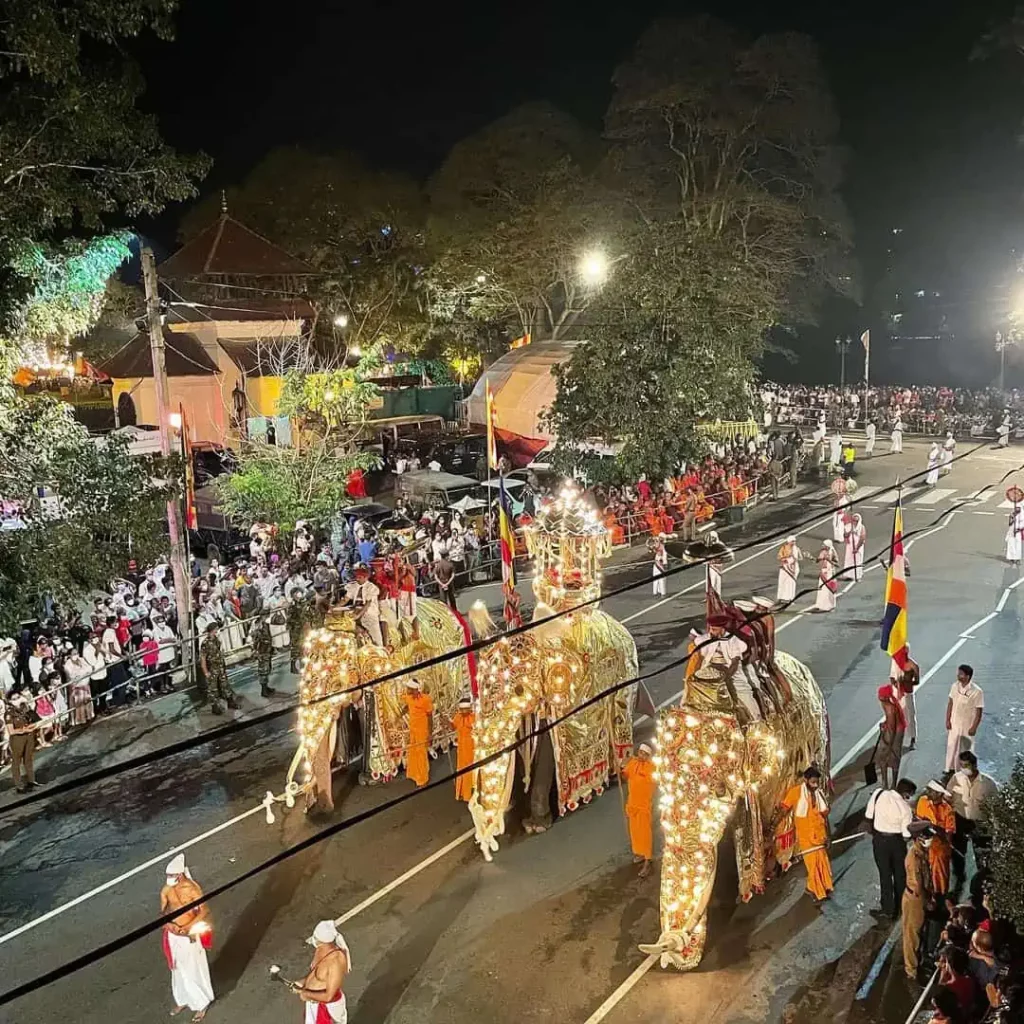
Integration of Cultural Elements:
As the Perahera evolved, it began to incorporate elements from different cultural traditions. Hindu deities, local folk beliefs, and customs became intertwined with the Buddhist rituals, showcasing the cultural diversity of Sri Lanka.
Influence of Colonial Rule:
During the period of colonial rule, the Esala Perahera underwent significant changes. The Portuguese, Dutch, and British colonizers imposed restrictions on Buddhist practices and ceremonies. As a result, the Perahera was temporarily banned or scaled down during these periods. However, it managed to survive and adapt to the changing circumstances, emerging stronger after the colonial era.
Modernization and Spectacle:
In recent decades, the Kandy Perahera has embraced modern technologies and production techniques to enhance the spectacle. Colorful lighting amplified sound systems, and elaborate stage designs have been incorporated to create a visually stunning experience for spectators.
Increased Tourism and Global Recognition:
The Kandy Esala Perahera has gained international acclaim and attracts a significant number of tourists each year. This exposure has led to greater recognition and understanding of the festival’s cultural significance beyond Sri Lanka’s borders.
Preservation of Tradition:
While the Kandy Perahera has adapted to changing times, efforts have been made to preserve its core traditions and rituals. The custodians of the Temple of the Sacred Tooth Relic and various cultural authorities strive to maintain the authenticity and sanctity of the festival.
Promoting Accessibility and Inclusivity:
In recent years, there has been a focus on making the Esala Perahera more accessible and inclusive. Measures have been taken to improve facilities for spectators, enhance the participation of diverse communities, and promote gender equality in the roles and performances within the Perahera.
Through these evolutions, the Kandy Perahera has retained its cultural and religious significance while embracing change. It continues to be a vibrant celebration of Sri Lankan heritage, showcasing the country’s rich traditions and captivating the hearts of both locals and visitors alike.
Rituals and Preparations
The elaborate preparations leading up to the Esala Perahera
The preparations leading up to the Kandy Esala Perahera are an intricate and meticulous process, involving various individuals, organizations, and communities. These preparations are essential to ensure the smooth execution and grandeur of the festival. Here is a description of the elaborate preparations:
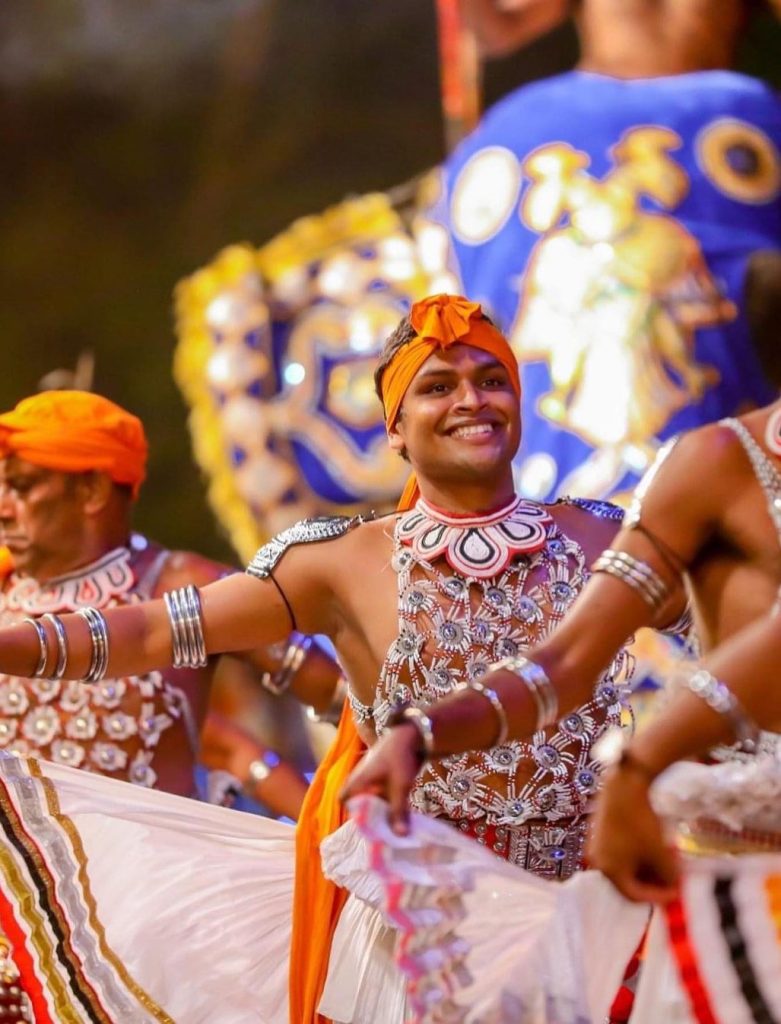
Selection and Training of Participants:
- Experienced officials and committees are appointed to oversee the organization of the Perahera.
- Dancers, drummers, fire performers, and other participants are selected based on their skills and expertise.
- Months before the festival, rehearsals and training sessions take place to perfect the performances and synchronize the movements.
Construction of Traditional Costumes and Decorations:
- Extensive outfits and accessories for the participants are made by skilled artisans and craftsmen.
- The elaborate embroidery, beading, and vivid colors of traditional clothing are painstakingly produced.
- Ornate jewelry, masks, and headpieces are also created, showcasing the rich cultural heritage of Sri Lanka.
Preparation of Elephants:
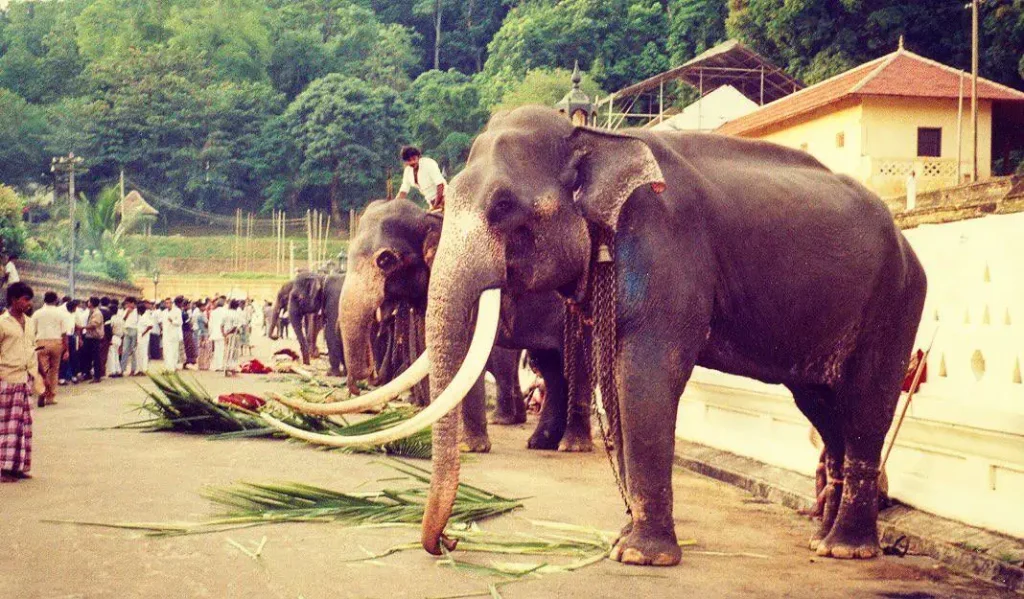
- Elephants are important participants in the Perahera, and extensive preparations are made to ensure their safety and participation.
- Elephants are selected based on their temperament and behavior, and they undergo a period of training to familiarize themselves with the processions and noise.
- Before the festival, the elephants are bathed, groomed, and adorned with decorative garments and ornaments.
Construction of Processional Structures:
- Elaborate processional structures known as ” Randoli Perahera” are built to carry the sacred tooth relic and the custodian, the Diyawadana Nilame.
- Skilled craftsmen construct these structures with intricate carvings, colorful paintings, and decorative elements, symbolizing the grandeur of the festival.
Arrangement of Lighting and Sound Systems:
- The streets of Kandy are adorned with thousands of colorful lights, creating a magical ambiance.
- Sound systems are strategically placed to amplify the traditional music, chants, and religious hymns throughout the procession route.
Organization of Security and Crowd Management:
- Adequate security measures are implemented to ensure the safety of participants and spectators.
- Crowd control barriers and designated viewing areas are set up to manage the large number of visitors attending the festival.
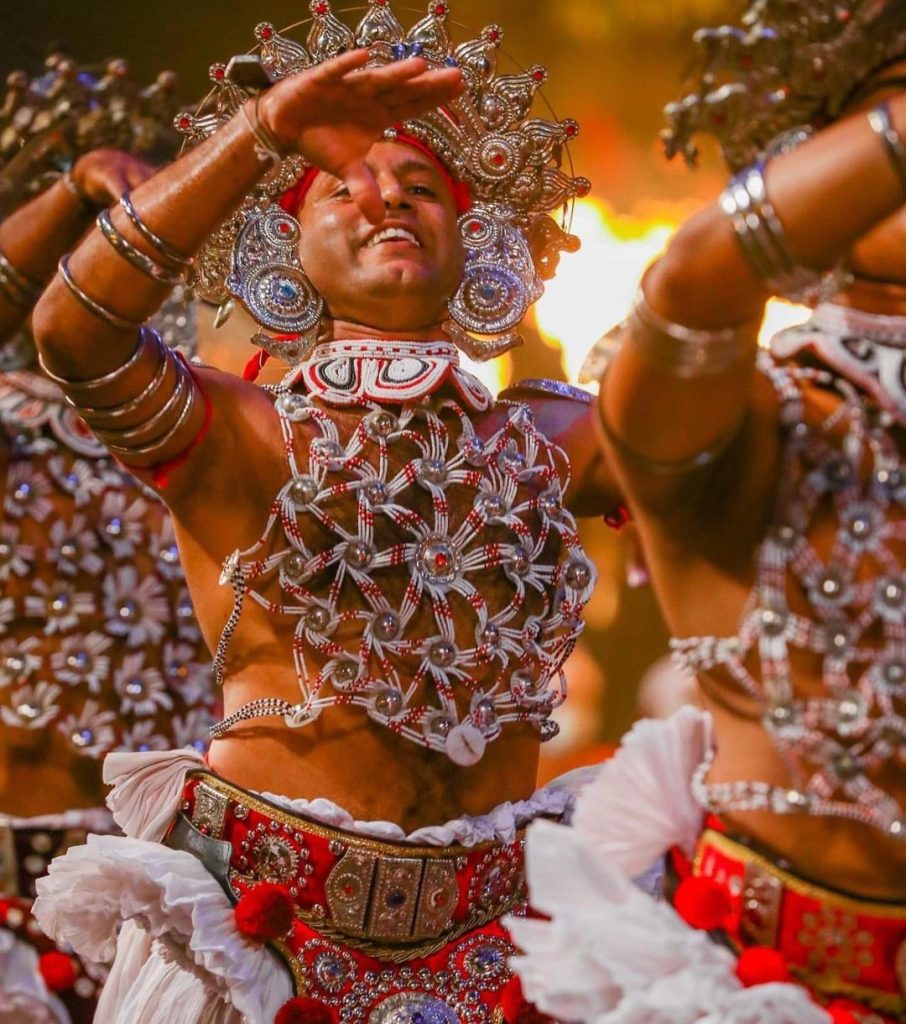
Coordination with Local Communities:
- The local people in Kandy’s vicinity actively take part in the preparations providing the guests with assistance, support, and hospitality.
- Families who live near the procession path deck out their residences, public spaces, and commercial establishments to add to the festive ambiance.
The effort, skill, and spirit of cooperation displayed by Sri Lankans are best exemplified by the preparations for the Kandy Esala Perahera. All of these initiatives help to provide a breathtaking sight that captures the attention and hearts of everyone who sees the festival’s magnificence.
The religious rituals and ceremonies performed during the festival
During the Kandy Perahera, several religious rituals and ceremonies are performed, infusing the festival with profound spiritual significance. These rituals honor the sacred tooth relic of the Buddha and invoke blessings from deities, seeking protection and prosperity. Here is an explanation of the key religious rituals and ceremonies:
Kap Situveema:
- This ritual marks the planting of a sanctified young jackfruit tree at the four main Devales (shrines) dedicated to Hindu deities.
- It symbolizes the unity and harmony between Buddhism and Hinduism in Sri Lanka.
Calling of the Inner Devale:
- Representatives from the four main Devales gather at the Temple of the Sacred Tooth Relic to request permission to participate in the Perahera.
- This signifies the coming together of diverse religious traditions to honor the sacred tooth relic.
The Lighting of the Perahera Torch:
- A chosen devotee carries a torch lit from a flame at the historic Magul Maduwa Audience Hall and proceeds to light the main Perahera torch.
- This ritual symbolizes the illumination of wisdom and the passing of the sacred flame through generations.
Gajanayake Nilames Ceremony:
- The Gajanayake Nilames, custodians of the two main temples of Kandy, perform various rituals to seek blessings and protection.
- They offer religious offerings and perform specific rites, demonstrating their commitment to upholding religious traditions.
Water Cutting Ceremony:
- As the Perahera approaches the Mahaweli River, the water-cutting ceremony takes place.
- A procession of elephants led by the Basnayake Nilame (chief custodian) arrives to symbolically collect water from the river for ritual purposes.
The Water Cutting Ritual:
- This ritual involves the offering of lit oil lamps, carried by participants, as a sign of devotion.
- Thousands of oil lamps are presented, illuminating the Perahera route and creating a sacred and ethereal atmosphere.
- These religious rituals and ceremonies reflect the deep-rooted spiritual traditions and cultural heritage of Sri Lanka. They enhance the spiritual aura of the Kandy Esala Perahera, making it not only a vibrant cultural spectacle but also a profound religious experience for both participants and spectators.
Parade and Procession
The grandeur and scale of the Perahera parade
The Kandy Esala Perahera parade is a spectacle of grandeur and scale. It spans several nights, drawing thousands of spectators from around the world. The procession features a magnificent display of traditional elements, vibrant colors, and elaborate decorations. Majestic elephants, adorned with ornate garments and intricate jewelry, take center stage, carrying the sacred tooth relic.
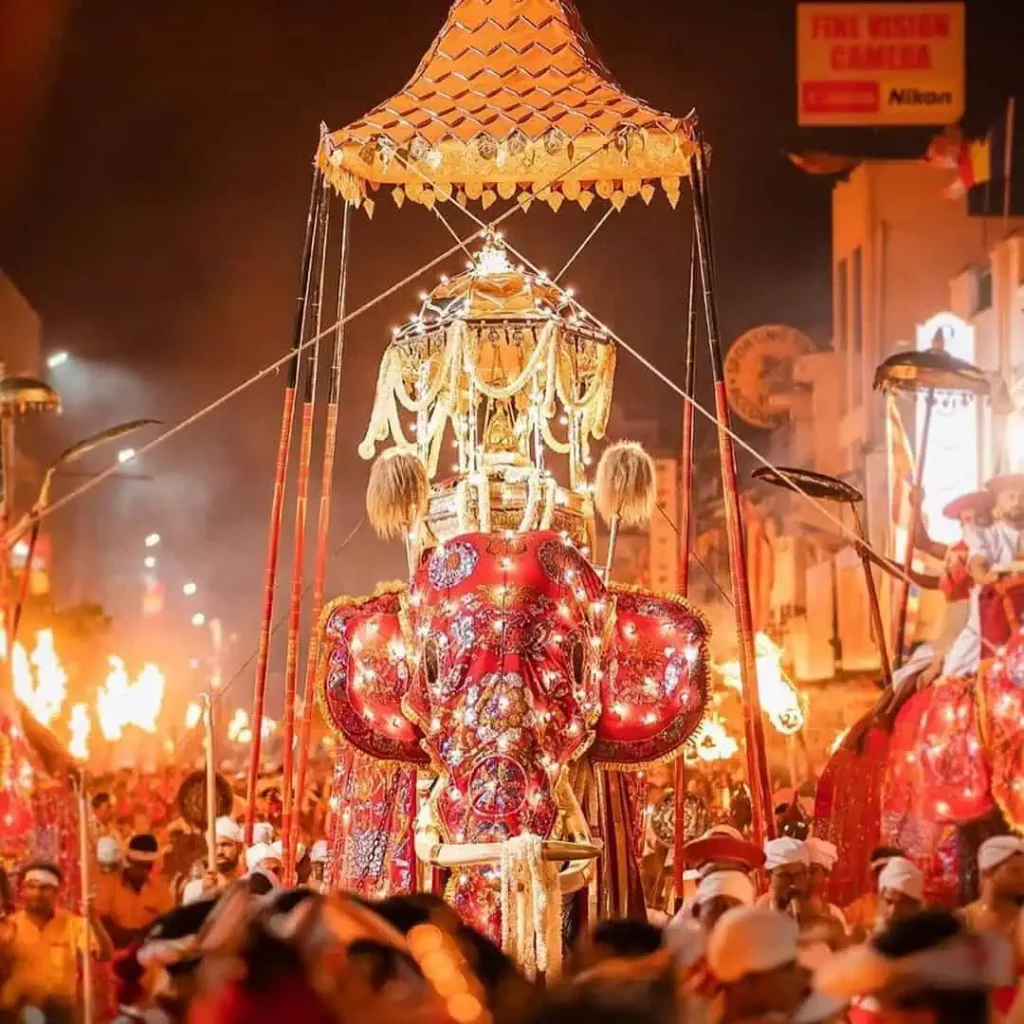
Accompanying the elephants are drummers, flutists, and other musicians creating rhythmic melodies that fill the air. The atmosphere is electric, with the streets illuminated by thousands of colorful lights, showcasing the splendor of the procession.
The traditional costumes and attire of participants
Participants in the Kandy Perahera parade don traditional costumes that reflect the cultural heritage of Sri Lanka. Dancers and drummers wear vibrant attire, adorned with intricate embroidery, beading, and sequins. The dancers’ costumes often include flowing skirts and elaborate headdresses, while drummers wear traditional vests and turbans.
The custodians of the temple and shrine processions don regal outfits, complete with ornate crowns and accessories. The participants’ attire showcases the richness of Sri Lankan craftsmanship and reflects the deep cultural traditions associated with the festival.
Highlight the mesmerizing dance performances, fire acts, and cultural displays
The Kandy Esala Perahera captivates spectators with mesmerizing dance performances, fire acts, and cultural displays. Dancers perform traditional Sri Lankan dances, such as Kandyan, Udarata, and Sabaragamuwa, characterized by graceful movements, intricate footwork, and colorful costumes.
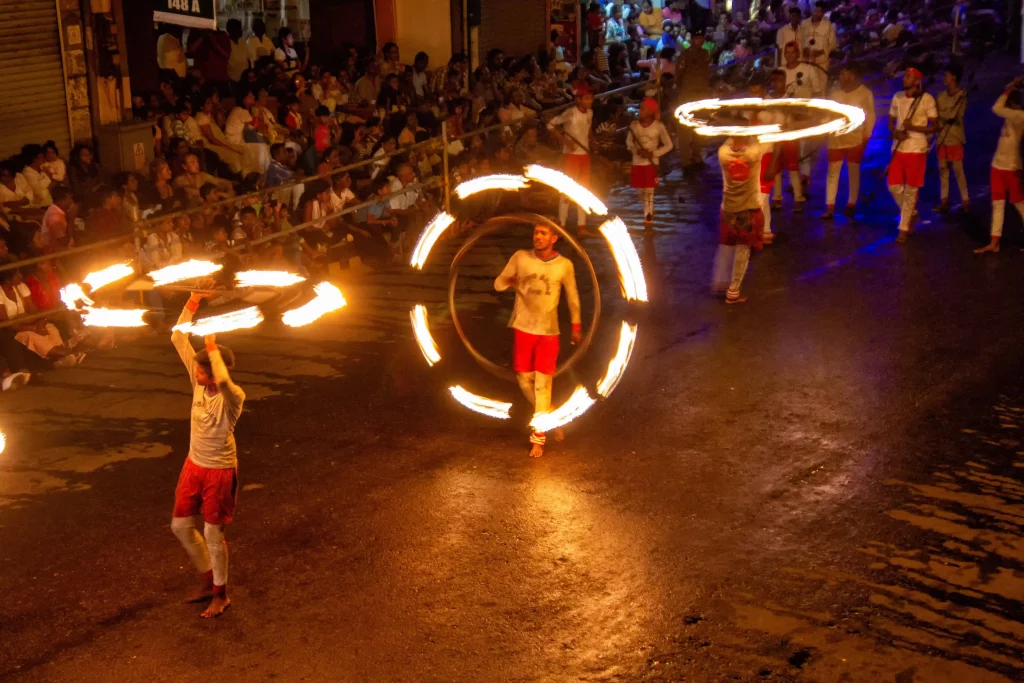
These dances depict mythical stories, historical events, and cultural narratives, captivating the audience with their artistry and precision. Interspersed throughout the procession, fire performers showcase their skills, twirling fire batons and creating a mesmerizing spectacle of flames against the night sky. Cultural displays, including traditional rituals, martial arts demonstrations, and folk performances, add to the enchanting ambiance, immersing spectators in the rich cultural heritage of Sri Lanka. The combination of dance, fire acts, and cultural displays makes the Kandy Perahera a truly unforgettable and awe-inspiring experience.
Cultural Significance
The cultural and religious importance of the Esala Perahera
The Kandy Esala Perahera holds immense cultural and religious significance in Sri Lanka. It is regarded as one of the most revered and grandest religious processions in the country. Here’s an exploration of its cultural and religious importance:
Cultural Importance:
- The Perahera showcases the rich cultural heritage of Sri Lanka, encompassing traditional music, dance, costumes, and rituals.
- It serves as a platform for preserving and promoting traditional art forms, craftsmanship, and performing arts.
- The festival allows locals and visitors to experience and appreciate the diverse cultural traditions that makeup Sri Lankan identity.
- It strengthens the sense of cultural pride and unity among Sri Lankans, reinforcing their shared heritage and values.
Religious Importance:
- The Kandy Perahera is deeply rooted in Buddhism, the predominant religion in Sri Lanka.
- The centerpiece of the Perahera is the sacred tooth relic of the Buddha, housed in the Temple of the Sacred Tooth Relic in Kandy.
- The procession symbolizes the veneration and protection of the sacred tooth relic, believed to bring blessings, prosperity, and spiritual well-being.
- It serves as an opportunity for devotees to pay homage to the relic, seek spiritual solace, and reaffirm their faith in Buddhism.
- The Perahera also includes religious rituals, offerings, and blessings conducted by Buddhist monks, further reinforcing its religious significance.
Community Participation:
- The Kandy Perahera fosters community participation and engagement.
- Local communities actively contribute to the preparations, hosting events, decorating homes, and offering hospitality to visitors.
- The festival provides a sense of belonging and collective celebration, strengthening community bonds.
- It brings together people from various backgrounds, promoting intercultural understanding, unity, and harmony.
Historical Significance:
- The origins of the Kandy Perahera can be traced back to ancient times, with historical records dating back centuries.
- The festival has withstood the test of time, surviving wars, colonization, and societal changes, symbolizing the resilience of Sri Lankan culture and religious traditions.
- It serves as a link to the country’s historical roots, preserving and honoring age-old customs and practices.
- The cultural and religious importance of the Kandy Esala Perahera is intertwined, making it a unique and cherished event in Sri Lanka. It celebrates both the cultural diversity and spiritual devotion of the Sri Lankan people, showcasing their deep reverence for their heritage and religious beliefs.
The role of the Perahera in promoting unity and harmony among communities
The Perahera plays a significant role in promoting unity and harmony among communities in Sri Lanka. This religious and cultural festival brings people from diverse backgrounds together, fostering a sense of shared identity and collective celebration. Here’s how the Perahera promotes unity and harmony:
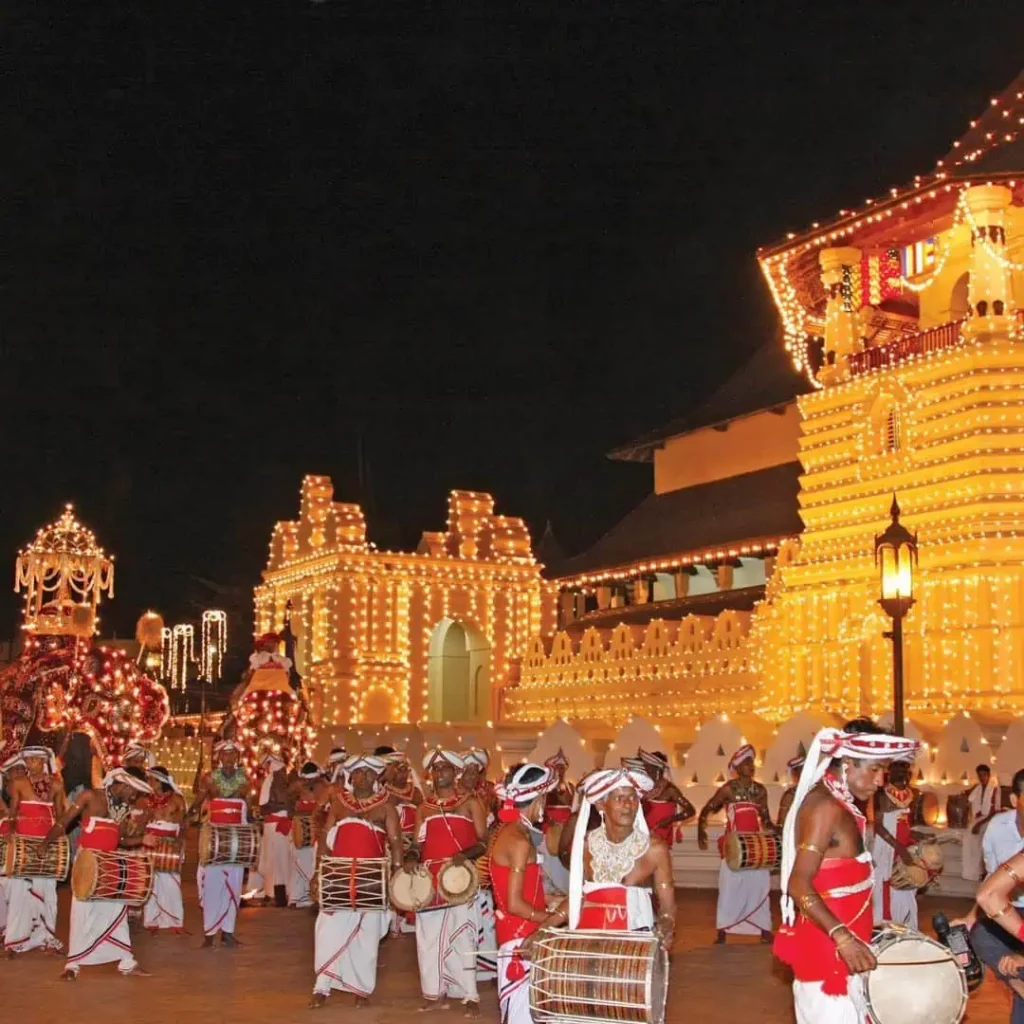
Interfaith Collaboration:
- The Perahera represents the peaceful coexistence of various religious communities in Sri Lanka through its distinctive fusion of Buddhist and Hindu traditions.
- The festival’s inclusion of both Buddhist and Hindu followers exemplifies respect, cooperation, and understanding between the two religions.
- The Devale Peraheras dedicated to Hindu deities highlight the inclusivity of the event, emphasizing the shared cultural heritage of Sri Lankan communities.
Community Participation:
- Regardless of their religious or cultural backgrounds, local communities are encouraged to actively participate in the Perahera.
- People from many communities get together to plan and contribute to the festival’s preparations, including decorations, concerts, and hospitality.
Bridging Cultural Differences:
- The Kandy Perahera showcases the diverse cultural traditions of Sri Lanka through vibrant costumes, traditional dances, music, and rituals.
Locals and visitors alike have the chance to view and appreciate the diverse communities’ rich cultural history. - The festival acts as a platform for cultural exchange, promoting understanding, tolerance, and appreciation of diverse customs and practices.
Promoting Peaceful Coexistence:
- The inclusive aspect of the Perahera, as well as its emphasis on religious and cultural compatibility, serve as a powerful symbol of peace and healing.
- The festival offers an opportunity for people to join together, set aside their differences, and honor a common cultural occasion.
- Promoting cooperation, friendliness, and goodwill among individuals and groups, creates a climate of acceptance and respect.
National Identity and Pride:
- The Kandy Perahera is deeply ingrained in the national identity of Sri Lanka, transcending regional and religious boundaries.
- It instills a sense of pride and unity among Sri Lankans, reinforcing their collective heritage and shared values.
- The festival serves as a unifying force, strengthening the sense of national identity and promoting a spirit of togetherness.
- By embracing diversity, promoting cultural understanding, and fostering a sense of collective celebration, the Perahera contributes significantly to the promotion of unity, harmony, and peaceful coexistence among communities in Sri Lanka.
Visitor Experience
Tips for attending the Kandy Esala Perahera as a visitor
Attending the Kandy Perahera as a visitor can be an incredible experience. Here are some tips
Plan And Book A Seat:
To ensure you don’t miss any major activities, check the festival’s dates and program in advance. It is necessary to establish the precise dates each year as the Perahera typically occurs in August.
Link- Click To Book A Seat
Arrive early:
The Perahera attracts large crowds, so arrive early to secure a good viewing spot along the procession route. Consider booking a seat in the spectator stands for a better view.
Dress appropriately:
Sri Lanka is a predominantly Buddhist country, so it’s respectful to dress modestly. Wear comfortable clothing and shoes as you may be standing or walking for an extended period.
Respect local customs:
Follow the instructions of the authorities and show respect for religious customs and traditions. Be mindful of photography restrictions and avoid using flash during religious rituals.
Capture memories respectfully:
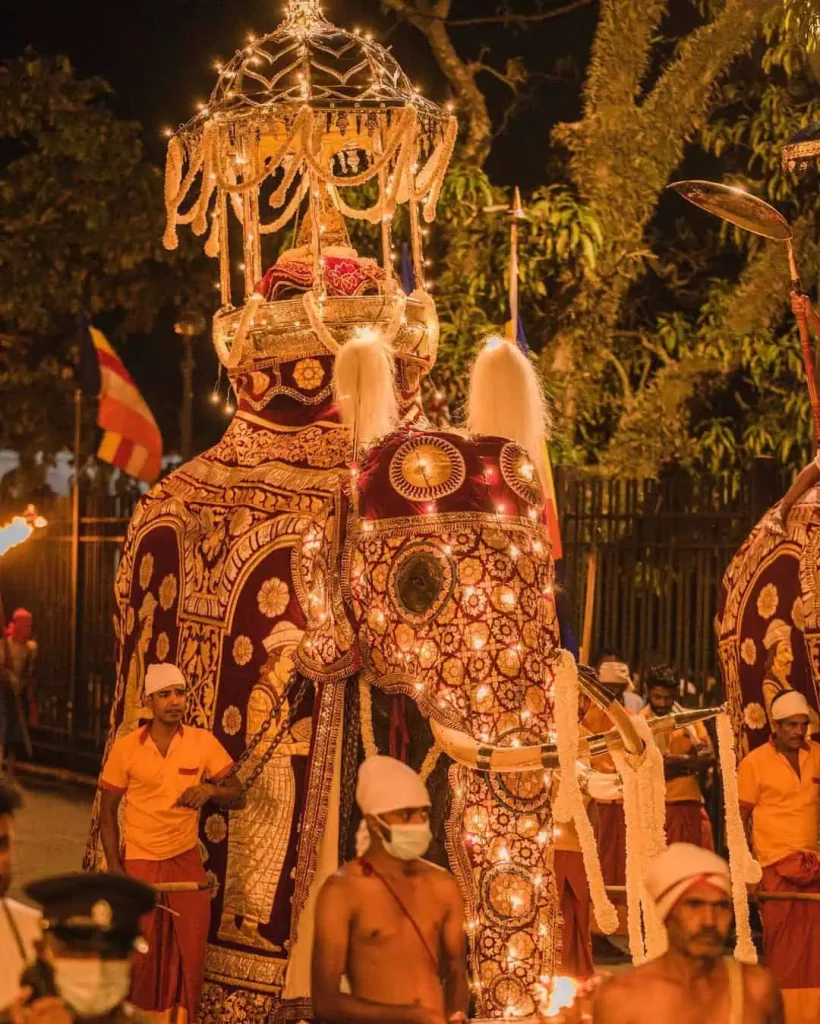
Photography is allowed, but be considerate of others and refrain from obstructing views or interrupting the procession. Be mindful of the sanctity of the event and respect the privacy of devotees.
Explore Kandy:
Take the opportunity to explore the city of Kandy beyond the festival. Visit the Temple of the Tooth Relic, explore the nearby attractions, and savor the local cuisine for a complete experience.
Follow local guidance:
Stay updated with any safety guidelines or announcements related to the Perahera. Follow the instructions of local authorities for a smooth and enjoyable visit.
The best vantage points and viewing spots
To ensure the best viewing experience of the Kandy Esala Perahera, consider the following vantage points and viewing spots:
Dalada Palace (Temple of the Tooth Relic):
- The starting point of the procession is from the Temple of the Tooth Relic, making it a prime location to witness the grandeur of the Perahera.
- Arriving early and securing a spot near the temple’s entrance provides an up-close view of the initial stages of the procession.
The Octagon (Ehelepola Mawatha):
- Located near the Temple of the Tooth Relic, The Octagon offers an elevated viewpoint for spectators.
- Being positioned higher than street level provides a broader view of the procession as it passes through the city streets
Upper Floor of Queens Hotel:
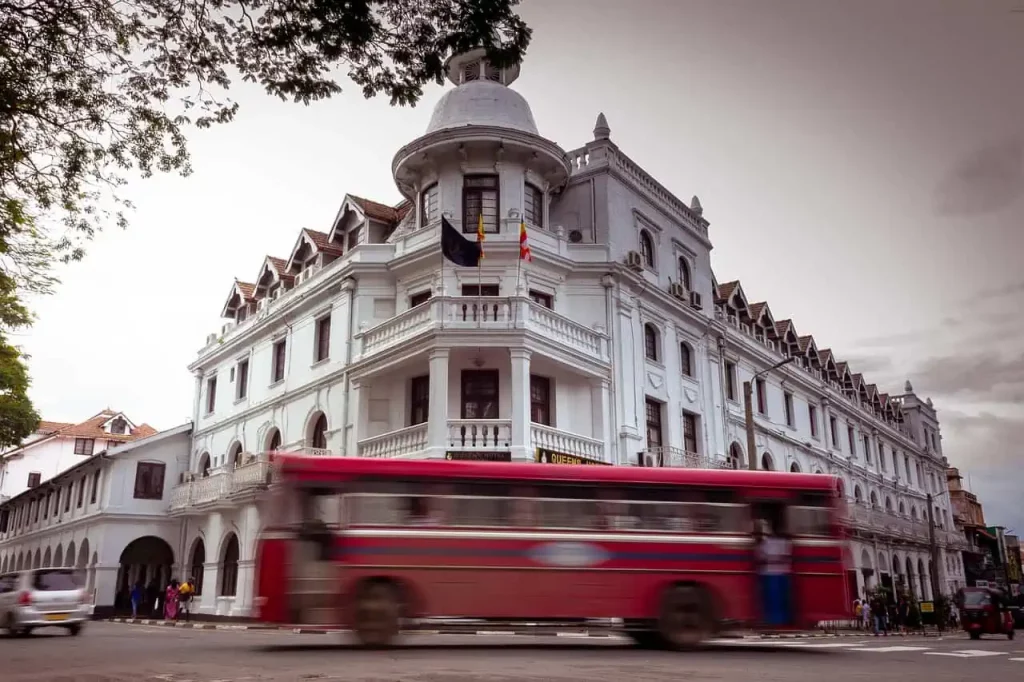
- The Queens Hotel, situated along the procession route, offers an elevated vantage point from its upper floor.
- This strategic location allows for a clear and panoramic view of the Perahera, especially if you can secure a spot near a window or balcony.
Trinity College Junction:
- Trinity College Junction, a busy intersection, offers an excellent viewing spot.
- Arrive early to secure a position along the sidewalk to witness the procession as it passes by, with the added advantage of the junction’s open space.
Street-level viewing spots:
- If you prefer a closer and more immersive experience, find a spot along the procession route on the streets of Kandy.
- Remember to arrive early to secure a prime viewing location and be prepared for crowds.
- Remember, popular viewing spots tend to fill up quickly, so arriving early is key to securing a good vantage point. Be respectful of others’ space and follow any instructions or guidelines provided by local authorities to ensure a safe and enjoyable experience.
Impact and Future
The economic and tourism impact of the Esala Perahera
The Esala Perahera festival in Kandy has a significant economic and tourism impact on Sri Lanka. Here are some
Boost to Local Economy:
- The festival draws a considerable number of tourists, both domestic and international, which boosts economic activity in the area.
- During the festival time, local businesses like hotels, guesthouses, restaurants, and shops see an increase in demand.
- Visitor spending on hotels, food, transportation, souvenirs, and other goods and services benefits the local economy.
Job Creation and Income Generation:
- The Kandy Perahera creates employment opportunities for various sectors, including hospitality, tourism, transportation, and handicrafts.
- The increased demand for services and products during the festival requires an additional workforce, leading to job creation and income generation for local communities.
- Artisans, performers, musicians, and traditional craftsmen also benefit from the festival, as their skills and products are in high demand.
Tourism Promotion:
- The Esala Perahera is one of Sri Lanka’s most renowned cultural events, attracting tourists from around the world.
- The festival serves as a significant attraction, contributing to the growth of tourism in the country.
- Tourists visit specifically to witness the grandeur and cultural heritage showcased during the Perahera, resulting in increased tourist arrivals and revenue for the tourism industry.
Cultural Heritage Preservation:
- The Esala Perahera plays a vital role in preserving and promoting Sri Lanka’s cultural heritage.
- The festival showcases traditional dance forms, music, costumes, rituals, and customs, preserving these elements for future generations.
- The focus on cultural preservation attracts individuals interested in experiencing and understanding Sri Lankan traditions and contributes to the country’s cultural tourism offerings.
Destination Promotion:
- The Esala Perahera enhances the reputation of Kandy as a cultural and heritage destination within Sri Lanka.
- The festival’s prominence and uniqueness attract both local and international travelers, putting Kandy in the spotlight as a must-visit location.
- The increased visibility and positive word-of-mouth generated by the Perahera contribute to the overall promotion of Kandy as a tourist destination.
Initiatives to safeguard and promote the Perahera for future generations
To safeguard and promote the Perahera for future generations, several initiatives are being undertaken in Sri Lanka. Here are some notable examples:
Conservation and Preservation Efforts:
- The custodians of the Temple of the Tooth Relic and relevant authorities are actively involved in preserving the Perahera’s historical and cultural significance.
- Efforts are made to safeguard the traditional rituals, costumes, and artifacts associated with the festival, ensuring their authenticity and integrity.
- Conservation measures are implemented to protect sacred objects, such as the relic casket, and maintain their condition for future generations.
Cultural Education and Training:
- Institutions and organizations offer cultural education programs and workshops to impart knowledge about the Perahera and its associated traditions.
- Traditional dance and music academies provide training and mentorship to young artists, ensuring the continuity of these art forms.
- These educational initiatives help preserve the skills and knowledge required for the Perahera and promote active participation among the younger generation.
Community Engagement and Participation:
- Local communities actively contribute to the organization and execution of the Perahera, fostering a sense of ownership and pride.
- Community organizations and associations play a crucial role in supporting the festival, volunteering their time and resources for its success.
- Encouraging community involvement ensures the Perahera remains a collective endeavor, passed down through generations with cultural authenticity.
Research and Documentation:
- Scholars, historians, and researchers undertake studies and documentation projects to preserve the Perahera’s history, evolution, and cultural significance.
- Documentation efforts include capturing oral histories, archiving photographs, and videos, and compiling written records for future reference.
Tourism Promotion and Awareness:
- The Sri Lankan government and tourism authorities actively promote the Kandy Perahera festival as a major cultural attraction, both domestically and internationally.
- Tourist information centers, travel agencies, and online platforms highlight the significance of the festival, encouraging visitors to experience and appreciate it.
- Tourism campaigns emphasize responsible tourism practices, cultural sensitivity, and respect for the religious and historical context of the Kandy Esela Perahera.
Conclusion
In the heart of Kandy, where tradition meets spirituality, the Esala Perahera stands tall as a cultural monument. Its grand procession, vibrant cultural performances, and religious significance weave a narrative that transcends time. As we bid adieu to another year of festivities, the echoes of the Esala Perahera linger, reminding us of the enduring legacy it leaves behind.
(FAQs)
- What is the significance of the Esala Perahera in Sri Lankan culture?
- The Esala Perahera holds immense cultural significance as a celebration of Sri Lankan identity and heritage. It is a manifestation of religious devotion, unity, and the rich tapestry of traditions.
- How has the festival evolved over the years?
- The festival has evolved by incorporating modern influences while preserving its cultural authenticity. It navigates the challenges of balancing tradition with the demands of the contemporary world.
- What role do sacred relics play in the Esala Perahera?
- Sacred relics, believed to be remnants of Buddha, play a central role in the festival. They add a layer of spirituality, turning the event into a profound religious experience.
- How does the Esala Perahera impact tourism in Sri Lanka?
- The festival attracts international tourists, contributing to the local economy. Hotels, restaurants, and businesses thrive during the festivities, showcasing the economic potential of cultural events.
- What challenges does the festival face in the modern era?
- Balancing tradition with modernity and addressing environmental concerns are some of the challenges faced by the Esala Perahera. The festival strives to preserve its authenticity while adapting to changing times.
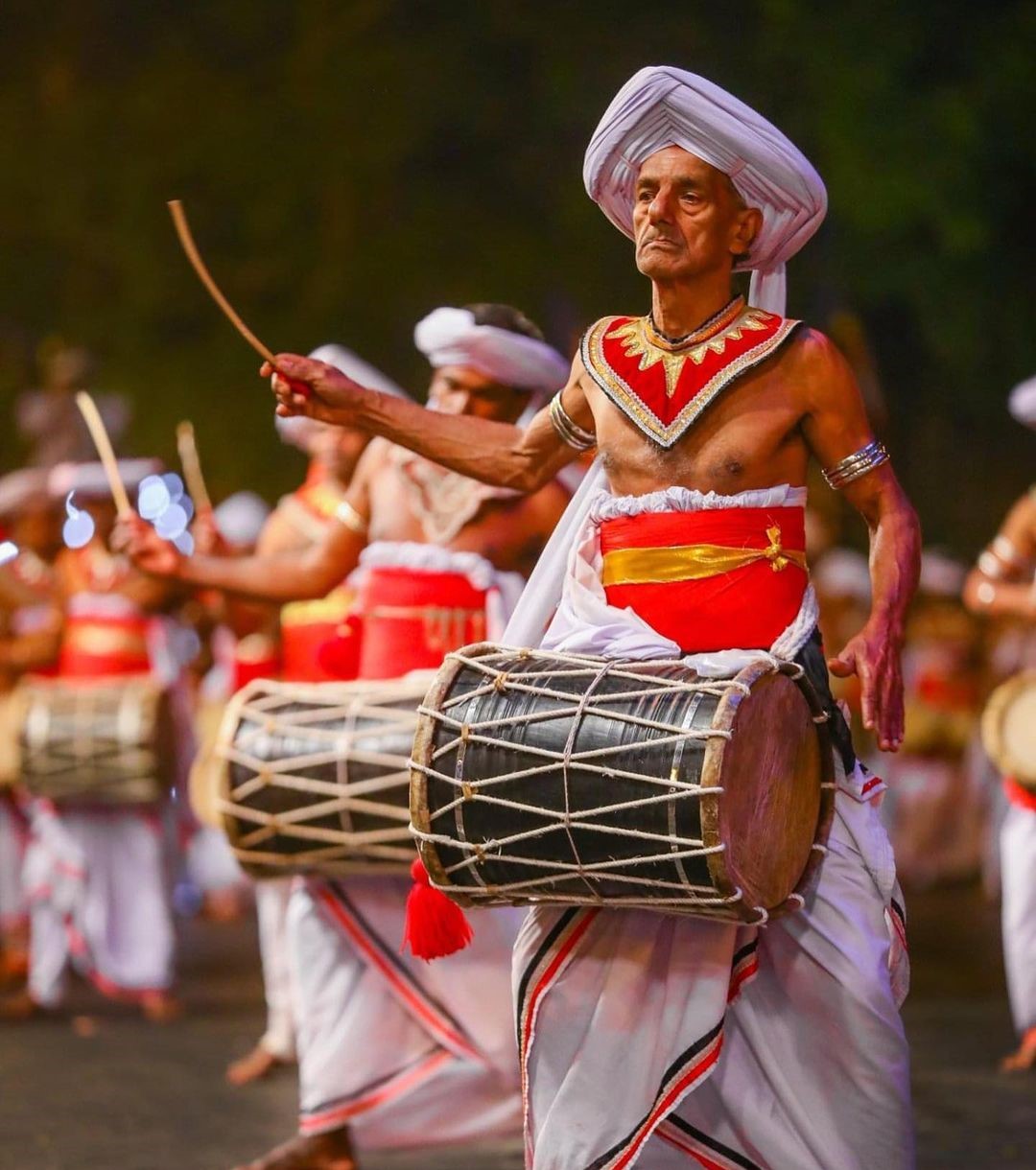
Comment (0)